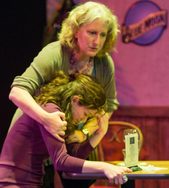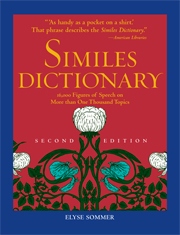SITE GUIDE
SEARCH
REVIEWS
REVIEW ARCHIVES
ADVERTISING AT CURTAINUP
FEATURES
NEWS
Etcetera and
Short Term Listings
LISTINGS
Broadway
Off-Broadway
NYC Restaurants
BOOKS and CDs
OTHER PLACES
Berkshires
London
California
New Jersey
DC
Philadelphia
Elsewhere
QUOTES
TKTS
PLAYWRIGHTS' ALBUMS
LETTERS TO EDITOR
FILM
LINKS
MISCELLANEOUS
Free Updates
Masthead
A CurtainUp Berkshire Review
The How and the Why
By Elyse Sommer
|
Does the 'grandmother hypothesis’ keep you warm at night? — Rachel
|

L-R: Bridget Saracino as Rachel and Tod Randolph as Zelda (Photo by John Dolan) |
Though 56-year-old Zelda Klein (Tod Randolph) has had her share of lovers, at twenty-eight she was not up to the challenges of being a single mother and making a name for herself in the male-dominated scientific research world. And so, she gave her baby up for adoption. This allows Treem to add the always explosive situation of adult adoptees seeking out their birth mothers, by making Rachel (Bridget Saracino) the second character that baby now also twenty-eight and a biological researcher .
The first act takes place in Zelda's office (nicely detailed by Patrick Brennan) just before a major conference of The National Organization of Research Biologists at the University where Zelda is a tenured professor. This gives the younger woman a double motive for being there — she wants Zelda who's on the board of the organization to have them reverse their decision about reject her request to present her abstract.
A set-up that screams contrivance? You bet.
But Ms. Treem is a gifted and original writer. Consequently, the contrivances don't sink The How and The Why. It's not on a par with her terrific first play Feminine Ending explored feminism from the unique perspective of a young classical music composer. That's also true for her more recent When We Were Young which reflected on the various feminist ideologies espoused since Betty Friedan's The Feminine Mystique. But plays with a science background are all too rare on the contemporary theater scene and Treem has managed to work two actual scientific theories into a fascinating fictional confrontation between her characters: one at the top of her career and one half her age eager to revolutionize the biological world with her own hypothethis. (The program's director's notes helpfully detail the factual details of both Zelda's Grandmother hypothethis based on the work of anthropologist Kristen Hawkes and Rachel's Defense Theory based the work of biologist Margie Profit — our New Jersey critic's review sums it all up even more concisely).
The jewel of this Shakespeare & Company production, is the stellar performance of Tod Randolph. This actress has a way of inhabiting a character with natural grace, bringing out a text's humor as well as its more poignant aspects. Sure enough, she makes the most of Treem's sparkling dialogue and maximizes the drama of the questions bound to arise between this mother and daughter as they confront each other with questions about their relationship, their personal needs, and their respective scientific theories. Randolph's pragmatic Zelda counters Rachel's talk about the "magic" of love by likening it to the "Stockholm Syndrome" and a wry "You want to know what love is? It's stress."
Blame Treem for giving Zelda the smartest lines and making Rachel a less sympathetic or believable character. But the actress playing Rachel could nevertheless hold her own (which seems to have been the case at the MCCarter). Unfortunately this isn't the case for this production's Rachel. Bridget Saracino is too strident and Nicole Ricciardi's direction doesn't help. The wide stage of this venue and the two thrust sections are a challenge for any director. However, Ms. Ricciardi has not moved her actors around with the people in those side sections in mind. Several people I know who were in those seats told me at intermission that they never saw anything but Rachel's back. Worse yet, this made it hard to hear her and often blocked their view of Randolph's Zelda.
The bar in which the second act takes place further exacerbates some of the awkward blocking. The desk in Patrick Brennan's first act office scene could easily have been moved off stage, and the center section adjusted with less fuss and more intimacy for the women's meeting in a bar after the conference.
Despite it's flaws The How and the Why is fascinating exploration of a world most of us aren't familiar with. Hopefully, the more high profile and higher paying world of TV and on-line streaming (Treem was a key writer for both the In Treatment TV series and the big Netflix hit House of Cards) won't prevent this savvy playwright from continuing to write for live theater.
Curtainup has maintained a page of science plays reviews, with brief synopses and a link to the full review. To check it out go here .
|
The How and the Why by Sarah Treem Directed by Nicole Ricciardi Cast: Tod Randolph, Bridget Saracino Sets: Patrick Brennan Costumes: Deborah Brothers Original Music & Sound: Alexander Sovronsky Lighting: James W. Bilnoski Stage Manager: Laura Kathryne Gomez Running Time: Approx. 2 hours, including 1 intermission Act I about 55 minutess and Act II about 45 minutess From 5/22/15; opening 5/30/15; closing 7/26/15 Bernstein Theatre at Shakespeare & company Reviewed by Elyse Sommer on July 1st |
|
REVIEW FEEDBACK Highlight one of the responses below and click "copy" or"CTRL+C"
Paste the highlighted text into the subject line (CTRL+ V): Feel free to add detailed comments in the body of the email. . .also the names and emails of any friends to whom you'd like us to forward a copy of this review. For a feed to reviews and features as they are posted add http://curtainupnewlinks.blogspot.com to your reader Curtainup at Facebook . . . Curtainup at Twitter Subscribe to our FREE email updates: E-mail: esommer@curtainup.comesommer@curtainup.com put SUBSCRIBE CURTAINUP EMAIL UPDATE in the subject line and your full name and email address in the body of the message. If you can spare a minute, tell us how you came to CurtainUp and from what part of the country. |


 Fun Home -CD
Fun Home -CD The King and I -CD
The King and I -CD American in Paris -CD
American in Paris -CD